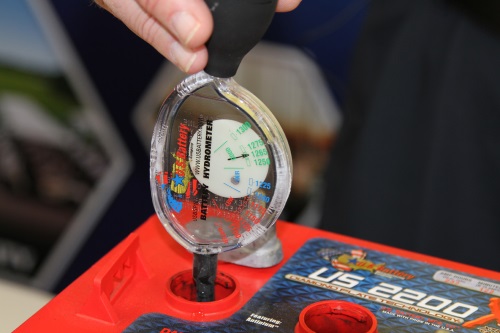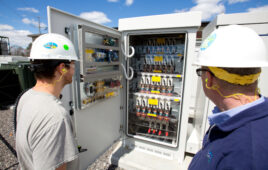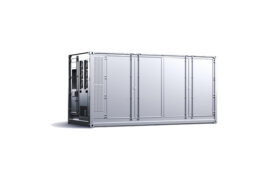By Fred Wehmeyer, Senior Vice President/Engineering U.S. Battery Manufacturing
Using a hydrometer is still the quickest and simplest way to determine the state of charge of the flooded lead-acid batteries in your solar battery system.
One of the advantages of a flooded lead-acid battery is the ability to quickly determine the battery’s state of charge. In renewable energy applications, batteries usually receive a daily charge—a current and voltage controlled charge that is fed to the battery. As solar exposure changes or as solar panels and batteries age, conditions may develop that prevent the batteries from receiving a full charge. So it’s always important to check the state of charge and determine the health of each battery cell.
Fortunately, this is easy to do on flooded lead acid batteries. Most will have removable vent caps that allow you to use a hydrometer to measure the specific gravity of the electrolyte, which will tell you the state of charge in each of the battery’s cells.
Electrolyte specific gravity changes with the charge state of the battery. When a battery is fully charged, all the available sulfates are contained in the sulfuric acid electrolyte and this raises the specific gravity of the electrolyte. As the battery discharges, the sulfates in the electrolyte move back into the plates and this lowers the specific gravity of the electrolyte.

Load testers and electronic battery checkers provide valuable information, but using a hydrometer provides the most reliable state of charge information. Using a hydrometer to check the battery state of charge is simple if you follow these steps after making sure that the battery is fully charged:
1) Make sure you are in a properly ventilated area and that you are equipped with safety equipment such as gloves and eye protection.
2) Use a high quality battery hydrometer. Most are made from plastic and have a float with various specific gravity and/or state of charge readings shown on them.
3) Remove the battery vent caps according to the manufacturer’s recommendations.
4) Insert the hydrometer into one of the battery’s cells and draw in some electrolyte, then squirt it back into the cell. This mixes the electrolyte so you can get a good reading.
5) Draw in electrolyte a second time and allow a few seconds for the float to settle so that it can give a stable reading.
6) Write down the reading indicated on the hydrometer float. Readings should be corrected for temperature using the following correction factors:
- a) Add 0.004 for each 10⁰F above 80⁰F; add 0.005 for each 7⁰C above 27⁰C
- b) Subtract 0.004 for each 10⁰F below 80⁰F; subtract 0.005 for each 7⁰C below 27⁰C
- c) Some hydrometers automatically correct for temperature and do not require correction.
7) Repeat the procedure on each of the battery’s cells and write down the readings.
8) If any electrolyte has dripped or spilled onto the battery, carefully wipe with a paper towel.
9) Reinstall the vent caps onto the battery.
10) Check the manufacturer’s specifications on the particular battery you’re using to determine the fully charged specific gravity reading.
The manufacturer’s specifications for battery open circuit voltage (OCV) vs state of charge (SOC) are listed by battery voltage and also show specific gravity (SG) vs state of charge. This information, typically found on the battery manufacturer’s website, can reveal much about the battery. First, if both the OCV and SG are below the manufacturer’s specifications, the battery is discharged and should be recharged. If only one cell is low and the others are within factory specifications, the battery may have a bad cell. If all cells have low SG’s that increase very slowly with charging, then the entire battery may be sulfated and may require special charging procedures to fully recover. If all the specific gravity readings are increasing while on charge, the battery is not fully charged and charging should be continued. At full charge the specific gravity will eventually stop increasing. At that point, the battery is fully charged. If SG’s have stopped increasing but are still below the manufacturer’s specifications, the battery may have lost acid from the electrolyte through spillage or over-watering. Consult the battery manufacturer for corrective actions.
If you follow these procedures for using a hydrometer, you’ll be able to save time in providing proper maintenance for your batteries, and continue to make sure they provide optimum performance.
To find additional resources on battery maintenance and ways to increase battery efficiency and service life, visit www.usbattery.com.





Can this been done while the solar system is running ?
Hello,
You talked about flodded batteries, but What about measuring the state of charge of maintainance free lead-acid batteries?. What measuring tools can be used for that?
Thanks
Hi.
I love your article. I am curious though, what is the most ideal method of testing a battery’s state of charge?
I read that using the open circuit voltage is not ideal most times, so I would love to know an ideal method. Thanks.